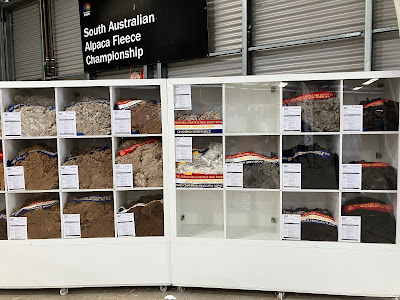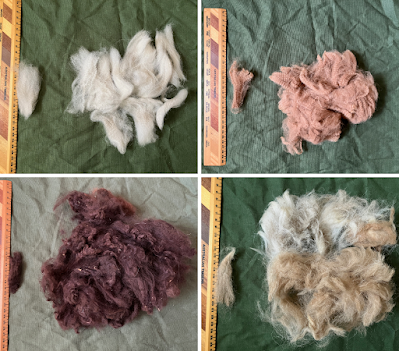The Royal Show is on this week. Being in need of free entry civic minded, I volunteered to help man the spinner's and weaver's guild stall.
This gives me half a day to wander the showgrounds, and half a day where I stand at the booth, spindle spinning for the public, and blowing people's minds with random facts like "This is how people spun thread for most of human history, the treadle spinning wheel was only invented in the 1500s" and "It took longer to spin and weave the sails for a Viking longship than it did to build the ship itself". Kids in particular love to see how thread is made.
My first shift this time was a morning one (I only slightly regret that choice, being that I Am Not A Morning Person). So of course the first thing I did when I knocked off was go and talk to the alpaca breeders. (They were easier to find than the sheep.)
I must have arrived at a good time, because I had a great chat with the rep manning the Alpaca Association stall in the building. I have a keen interest in the local fibre industries, for obvious reasons. So I always take the time to talk to anyone involved with it, in any capacity.
 |
| This is about half of the comptetion fleeces that were on display. |
So how are alpaca doing?
While alpaca have only been in the country for 30 years or so, herd numbers have been growing dramatically in the last half decade as farmers start to focus on fibre production (and to a lesser extent, meat) as well as genetics. The rep (I regret not getting his name now) reckons some sheep farmers, who have traditionally been resistant, will likely start switching over to alpaca in the next decade or so as they start to realise the advantages alpaca have. (Personally I think integrating alpaca alongside other things is the way to go - diversity creates stability, resilience, and higher yields.)
One of the reasons for his prediction is that alpaca are simply better suited to large chunks of the climate here than merino sheep. (Merino are, to put it politely, too overbred for wool production to cope.) They're softer footed, for one. I know that doesn't seem like a big deal, but Australia's soils are ancient. They were absolutely wrecked within fifty years of sheep, cattle, and other hard-hoofed animals being introduced. Returning to soft-footed grazers, in conjunction with regenerative pasture practices, would go a long way to fixing the damage and sequestering carbon back into the landscape.
Genetics, fleeces and microns, oh my!
Many farmers are focussing their breeding programs on two things - extending the amount of time their animals keep producing a low-micron fleece, and improving the consistency of micron count across the fleece as a whole.
In "unimproved" animals, the fleece will be coarser in some areas and finer in others. Think about human hair - different parts of our body have coarser or finer hair, too. In alpaca, the finest fleece is found on the saddle and neck. The belly and legs are coarser, and have more guard hairs (they're the tough, prickly ones). Breeders have been working to bring the fleece as a whole closer to the same fine-ness for a couple of decades.
 |
| Please forgive my drawing skills. I couldn't find a better copyright free image. |
Fleece quality changes as alpaca age, too. Unimproved animals usually give a year or two of fine fleeces, and then the wool gets coarser with each clip. The rep I talked to said that his herd's animals now hold their fleece consistency to about 5-6 years old. (He has one dam that has held her fleece for 8 years - he's really hoping those genetics can be passed on to her young!)
Why is this important? Because finer, more consistent fleeces are worth more. (There's a limit to how fine you want to go, though - commercial machinery doesn't like extremely fine fleece, so the ideal is 18-24 microns. That's still next-to-skin soft, for most people.)
Part of the complexity of raising commercial alpaca fibre is the range of colours (there's two dozen recognised in Australia), that you then have to sort and grade by micron count (there are four grades used by the industry), into 150kg bales for sale. Most farmers choose to breed either suri or huacaya, not both, because of that complexity.
Alpaca fleeces that only have two grades of fibre, or even one, are quicker and easier to sort at shearing time. That means less expense for the farmer, and a better profit margin.
Another way farmers cut the complexity is to focus on breeding specific colours, such as pure black, that are in high demand from the fashion industry.
Shearing and staples
Alpaca, like most sheep breeds, have lost the ability to naturally shed their fleeces. They must be sheared regularly to keep them healthy.
Shearing season in Australia is usually an annual event, due to cost. It starts about now (September) in the greater Adelaide region, has been going for a month or more up in Queensland, and the highlands here and in NSW/Victoria won't start until October or later. Every animal gets done at the same time, starting from about six weeks old. That way the animals are happier over summer, and it keeps their fleece quality higher.
Part of that fleece quality is the length of the wool, or staple. The ideal staple length for fleeces is 80-120mm - that's the sweet spot for both commercial processing machinery and handspinners. While handspinners definitely have the capacity to spin short fibres, most aren't interested in a fleece with less than 80mm staple. (I am an outlier in that if a fleece is nice, I don't care what staple length it has. I will find a use for its yarn.)
Another factor is the amount of VM (vegetable matter, such as grass seeds - clover burr is a particular problem) and dirt in the fleece. You can't do much about the dirt - alpaca *love* to roll, it helps to keep their coat healthy - but farmers do their best to keep VM low. Commercial buyers and handspinners alike appreciate it. (The example fleece the booth had out for touchies had too much VM in it to sell to handspinners. It didn't look like much to me, but again, I have lower standards than many of my kind.)
Personally, I love spinning alpaca. I find it easier to process than sheep since it doesn't need scouring. Dirt falls right out as you're spinning, and in the washing of the yarn (I spin it unwashed in the traditional Andean way). The natural colours are gorgeous, and it takes dyes well. The one downside for me is that it's so much warmer than sheep. Great for the being outside in the depths of winter, not so good for the rest of the year.
Overall I'm excited to see where the local alpaca industry heads over the next decade. I think there's great promise for improving the sustainability of our fibreshed, and for alpaca farming to be integrated into broader regenerative agriculture practices.

No comments:
Post a Comment